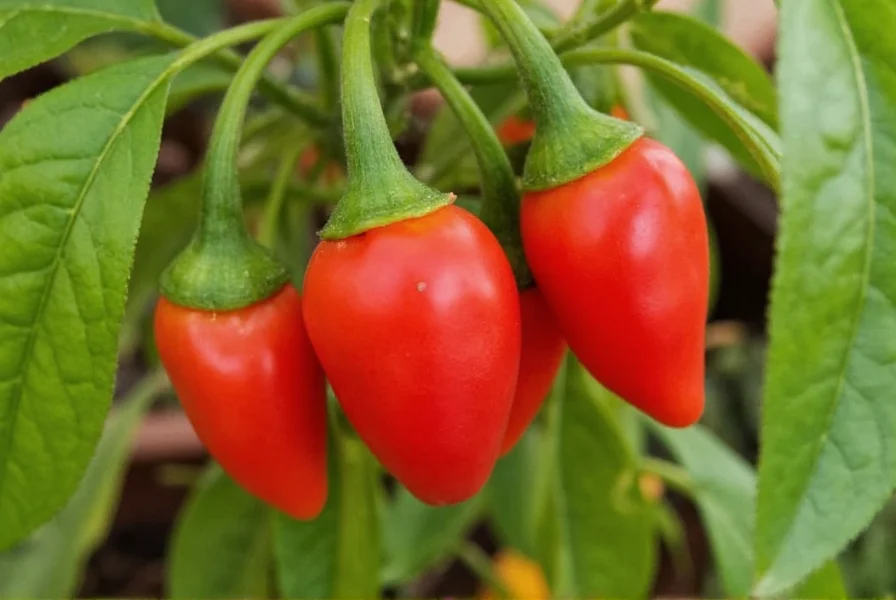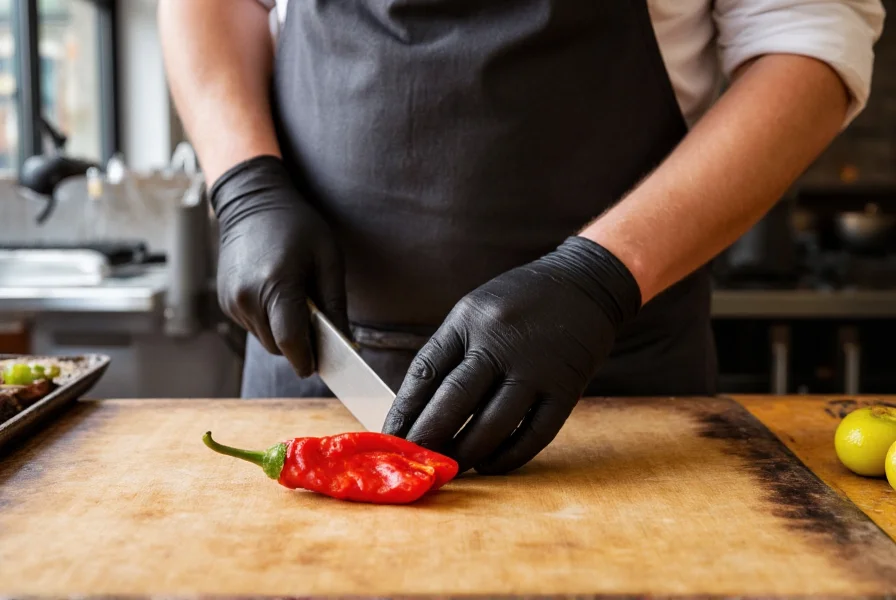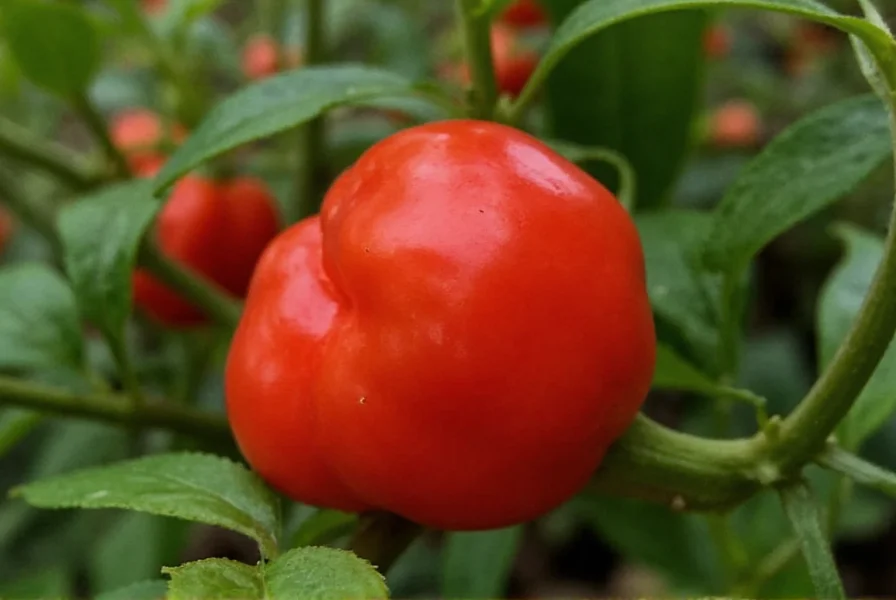The Trinidad Scorpion pepper represents one of nature's most potent culinary challenges. Developed in Trinidad and Tobago, this Capsicum chinense variety earned its name from the distinctive stinger-like tail on the pepper's tip. Understanding this super-hot chili requires examining its unique characteristics, growing requirements, and proper handling techniques.
Understanding Trinidad Scorpion Pepper Characteristics
Trinidad Scorpion peppers typically measure between 1.2 and 2 million Scoville Heat Units, placing them among the hottest peppers globally. For context, they're approximately 400 times hotter than a jalapeño and significantly hotter than the more commonly known habanero. The heat profile follows a distinctive pattern: initial fruity sweetness gives way to intense burning that can last 20-45 minutes.
These peppers grow to about 2 inches in length with a bumpy, lantern-shaped appearance. Their color transitions from green to vibrant red as they mature, though yellow and chocolate varieties also exist. The thin skin and small size belie their extraordinary heat potential.
| Pepper Variety | Scoville Heat Units | Relative Heat Comparison |
|---|---|---|
| Trinidad Scorpion | 1,200,000-2,000,000 | 400x jalapeño |
| Carolina Reaper | 1,400,000-2,200,000 | 450x jalapeño |
| Ghost Pepper | 800,000-1,041,400 | 250x jalapeño |
| Habanero | 100,000-350,000 | 40x jalapeño |
Origin and Development History
Despite common misconceptions, the Trinidad Scorpion wasn't discovered in the wild but selectively bred by Wahid Ogeer in Trinidad. The cultivar emerged around 2005 through careful cross-pollination of Trinidad Moruga Scorpion and other ultra-hot varieties. Its development represented Trinidad's contribution to the "super-hot" pepper arms race that dominated chili breeding in the early 2000s.
The pepper gained international recognition when it briefly held the Guinness World Record for hottest chili in 2011, before being surpassed by the Carolina Reaper. However, certain strains of Trinidad Scorpion still rival the Reaper in heat measurements.
Growing Trinidad Scorpion Peppers Successfully
Cultivating Trinidad Scorpion peppers requires specific conditions that mimic their native Caribbean environment. These peppers need 90-100 days to reach maturity from seed and thrive in temperatures between 75-90°F (24-32°C) with high humidity.
Successful growers recommend:
- Starting seeds indoors 8-10 weeks before last frost
- Using well-draining soil with pH 6.0-6.8
- Providing 12-14 hours of direct sunlight daily
- Maintaining consistent moisture without waterlogging
- Using containers for better temperature control
Many gardeners report better results when growing Trinidad Scorpion peppers in containers rather than directly in garden soil, as this allows for more precise temperature and moisture management. The plants typically reach 3-4 feet in height and produce 20-30 peppers per plant under optimal conditions.

Culinary Applications and Flavor Profile
Despite their fearsome reputation, Trinidad Scorpion peppers offer a complex flavor profile beyond just heat. They feature distinct tropical fruit notes—often described as apricot, mango, or citrus—with earthy undertones. This nuanced flavor makes them valuable in small quantities for hot sauces, preserves, and specialty dishes.
When incorporating Trinidad Scorpion peppers into recipes:
- Always wear gloves during preparation
- Remove seeds and membranes to reduce heat intensity
- Start with minuscule amounts (1/16 teaspoon of minced pepper)
- Allow dishes to rest for flavors to mellow and integrate
- Pair with sweet ingredients like pineapple or mango to balance heat
Chefs specializing in ultra-hot cuisine often use Trinidad Scorpion peppers in finishing sauces rather than cooking them extensively, as high heat can diminish their complex flavor profile while maintaining extreme spiciness.
Safety Considerations for Handling Super-Hot Peppers
Working with Trinidad Scorpion peppers requires serious safety precautions due to their extreme capsaicin concentration. Direct skin contact can cause severe burning sensations, and airborne capsaicin can irritate eyes and respiratory passages.
Essential safety measures include:
- Wearing nitrile gloves (latex won't protect against capsaicin)
- Using eye protection when cutting or processing
- Working in well-ventilated areas or under kitchen hoods
- Avoiding touching face or sensitive areas during handling
- Washing all surfaces and tools with soapy water afterward
If exposed to excessive capsaicin, dairy products like milk or yogurt provide the most effective relief due to casein's ability to break down capsaicin. Avoid using water, which spreads the oil rather than neutralizing it.

Trinidad Scorpion vs Other Super-Hot Peppers
While often compared to the Carolina Reaper, the Trinidad Scorpion offers a different heat experience. The Reaper delivers immediate, intense heat that peaks quickly, while the Scorpion provides a slower-building burn with more pronounced flavor notes before the intense heat arrives.
Compared to the Ghost Pepper (Bhut Jolokia), the Trinidad Scorpion is approximately 1.5-2 times hotter with a more complex flavor profile. Ghost Peppers deliver a sharper, more immediate heat with less nuanced flavor characteristics.
Pepper enthusiasts note that the Scorpion's heat has a more rounded, three-dimensional quality compared to some other super-hots, with the burn affecting multiple areas of the mouth and throat rather than concentrating in one spot.
Frequently Asked Questions
How does the Trinidad Scorpion pepper compare to the Carolina Reaper in heat?
While both peppers exceed 1.5 million Scoville units, the Carolina Reaper generally tests slightly hotter (1.4-2.2 million SHU) compared to the Trinidad Scorpion (1.2-2 million SHU). However, individual pepper heat can vary significantly based on growing conditions, and some Scorpion strains rival Reaper heat levels. The heat profiles differ too—the Scorpion delivers a slower-building, more complex burn while the Reaper hits faster with more immediate intensity.
Can you grow Trinidad Scorpion peppers in cooler climates?
Yes, but with significant accommodations. Gardeners in cooler climates should start seeds indoors 10-12 weeks before last frost, use containers for better temperature control, and consider supplemental heating. Growing in a greenhouse or sunroom provides the necessary warmth and humidity. Some growers use black plastic mulch to retain soil heat. The key is maintaining consistent temperatures above 70°F (21°C), as cooler temperatures stunt growth and reduce fruit production.
What's the best way to reduce the heat of Trinidad Scorpion peppers in cooking?
To reduce heat while preserving flavor, remove all seeds and white membranes (placenta) where capsaicin concentrates. Soaking minced pepper in milk or lemon juice for 15-30 minutes before use can further mellow the heat. Cooking with dairy ingredients like yogurt or cheese creates a buffer against the heat. For sauces, adding sugar or fruit purees balances the spiciness. Remember that heat intensifies over time, so allow dishes to rest before final seasoning adjustments.
How long do Trinidad Scorpion peppers stay hot after harvesting?
Properly dried Trinidad Scorpion peppers maintain their heat for 1-2 years when stored in airtight containers away from light and moisture. Fresh peppers retain maximum heat for about 2-3 weeks when refrigerated. Freezing preserves heat almost indefinitely—simply place whole peppers in freezer bags with air removed. The heat compounds (capsaicinoids) are remarkably stable, though flavor complexity may diminish over extended storage periods.











 浙公网安备
33010002000092号
浙公网安备
33010002000092号 浙B2-20120091-4
浙B2-20120091-4